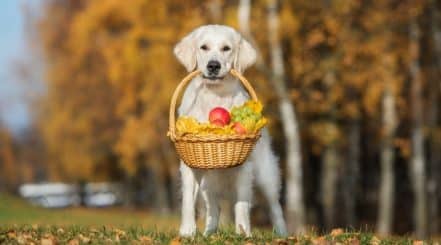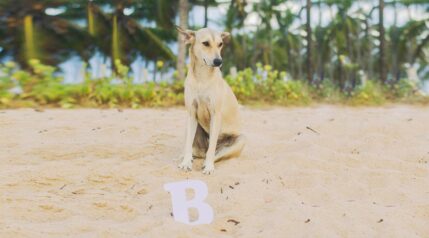Dogs love exploring plants in our homes and gardens, as well as rummaging in the undergrowth on walks. Dogs are omnivores, so they like to eat some plants (as well as meats) – but can plants be harmful to dogs?
Would a dog avoid a toxic plant because it tastes horrible? Not necessarily. Harmful plants don’t always taste bitter, so your dog might not know.
So how do you know which plants could be bad for your dog? And how do you stop your dog from eating them? Let’s take a look at with symptoms and risk levels.
Which Plants Can Harm My Dog?
There are lots of different plants that could cause harm to dogs – symptoms can range from a mild tummy upset to severe illness and death. It’s important you know which plants are the most dangerous and when to call your veterinarian.
There is a comprehensive list of toxic plants on the Cornell College of Agriculture and Life Sciences’ webpages, with handy pictures to help you identify them. These tables list common plants that harm dogs and some of the most poisonous plants for dogs.
Plants That Are Poisonous Or Dangerous For Dogs

Seasonal Plants
| Season | Plant | Danger level | Symptoms | Notes |
|---|---|---|---|---|
| Spring | Spring bulbs like daffodils, other narcissi, iris, and amaryllis | Risk to life | Sickness Diarrhea Itchy skin | Dogs that like digging may be more at risk |
| Larkspur and other delphiniums | Risk to life | Heart problems Skin irritation Tummy upset Depression Nervousness | The whole of the plant can be dangerous | |
| Summer | Oleander | High | Heart problems Severe sickness Severe diarrhea Skin irritation | Often found in parks, by the roadside, and in ornamental gardens. Plants may be brought indoors in cold weather. |
| Fall | Amaryllis | Risk to life | Sickness Diarrhea Skin itchiness | Bulbs are planted in fall to flower for Christmas or outdoors in spring. Bulbs grow on top of the compost, rather than buried in it, so are easy for dogs to snatch by mistake. |
| Winter | Moldy plants | Risk to life | Sickness Diarrhea Fitting (seizures) | Gardens may die back in the winter and plants may rot. Molds can be extremely dangerous to dogs. |
| Fungi | Risk to life | Range of symptoms, depending on the species of fungi | There are lots of different types of fungi that grow in damp, dark conditions. It is very difficult, even for experts, to tell the difference between varieties, and some are extremely toxic, so it’s best to avoid them all. |
Outdoor Plants
| Plant | Risk level | Symptoms | Notes |
|---|---|---|---|
| Angel Wings | Risk to life | Tummy upset Difficulty breathing Trembling Wobbliness Pain in the mouth Fitting | Has soft furry leaves so people plant it in their gardens where they can touch it, which means it will be in a dog’s reach too – so beware! |
| Castor bean | *HIGH* Risk to life | Skin itchiness Skin redness Sickness Loss of appetite Drinking more | Only a few castor bean seeds can kill a dog when eaten. Never feed your dog castor oil – and never use it on your dog’s skin – it’s not worth the risk |
| Water Dropwort or Water Hemlock | Risk to Life | Fitting – violent and painful | This plant causes illness very quickly |
| Rhododendron | Risk to life | Being Sick Feeling Sick Depression Difficulty breathing Coma | |
| Yew | Risk to Life | Dizziness Dry mouth Dilated pupils | Berries and leaves are dangerous |
| Wisteria | Medium | Being sick a lot Bad diarrhea, leading to Dehydration Collapse | The seeds and seed pods are the toxic part of this plant |
| Ragwort | *HIGH* Risk to life | Sickness Diarrhea Jaundice Depression Excessive drinking | Causes irreversible liver damage and even small doses can be fatal |
Indoor Plants
| Plant | Risk level | Symptoms | Notes |
|---|---|---|---|
| Dieffenbachia species – Dumbcane, Leopard Lily | Risk to life | Diarrhea Mouth irritation Skin irritation Tightening of the throat Difficulty breathing Tremors Fits | A popular houseplant |
| Cyclamen | Medium | Sickness Diarrhea Fits Paralysis | Cyclamen can be outdoor as well as indoor |
| Azaleas | Risk to life | Sickness Diarrhea Difficulty breathing Coma | All parts of the plant can be toxic and are a risk all year round. Can be indoors in pots or outdoors. |
Can Christmas Plants Hurt My Dog?

Christmas plants are lovely to add to the festive spirit, but some of them can cause illness in dogs.
Holly
Berries cause tummy upsets, wobbliness, and fitting in dogs. Leaves are pointy and can injure a dog’s insides.
Ivy
The whole of the plant can cause tummy upsets.
Mistletoe
Mistletoe berries can cause sickness, diarrhea, and skin irritation. This condition is usually treatable in older dogs but can be life-threatening in puppies.
Poinsettia
Poinsettia leaves, stems, and sap can cause sickness, diarrhea, and skin irritation. The sap also irritates (or, in severe cases, blindness) if it gets into a dog’s eyes.
Christmas Trees
Traditional Christmas trees are not toxic to dogs, but they can cause tummy upsets if eaten, and sharp needles can cause damage to a dog’s insides.
Are Human-Safe Plants Dangerous To Dogs?

While it is natural to assume that something is safe for us, it is also safe for our dogs. This is far from the truth. Here are a few examples:
Apricot, Cherry, Peach, And Apple
The seeds or pits inside these fruits contain cyanide, which is toxic to dogs. Apricot kernels are particularly potent. Cyanide poisoning can be life-threatening. This poisonous substance can also be found in apple seeds.
Avocado
The fruit and pit of the avocado are toxic to dogs, causing sickness, diarrhea, and difficulty breathing. The large pit can also cause a blockage in the guts. Both can be life-threatening.
Onion, Leeks, Garlic, And Chives
These plants are examples of alliums that should never be fed to dogs. They damage red blood cells, causing anemia, which can be life-threatening.
Grapes
Grapes cause kidney damage in dogs, and this can be life-threatening. The number of grapes it takes to cause illness is not set – some dogs are seriously ill after only a few. Since raisins are dried grapes, you should avoid feeding them to dogs as well.
Rhubarb
Raw leaves, growing in the garden, can cause fitting and coma if enough is eaten.
My Dog Has Eaten A Toxic Plant – What Should I Do?

You should call your veterinarian right away if your dog has eaten a plant that you think could cause him harm. Don’t wait for them to become ill. Getting early treatment can be lifesaving.
If your dog gets to the veterinarian promptly, they may induce vomiting. This can stop the body from absorbing harmful toxins and can avoid serious illness. Never attempt to make your dog sick at home. Veterinarians can make dogs sick in a safe way – at-home methods can be dangerous.
If you wait for your dog to become sick before seeking veterinary advice, it may be too late. Once toxins have been absorbed into the body, treatment takes longer, could become very expensive, and may not be successful.
My Dog Has Eaten a Poisonous Plant, What Will My Veterinarian Do?
If the plant your dog has eaten is only likely to cause mild illness, your veterinarian might send them back home with you. They might ask you to watch for new signs of illness, provide medication, or advise special food to help absorb bad things from the gut.
If the toxin is more serious, your vet might want to keep your canine at the clinic. They might give him an injection to make him sick. They may also need further tests, like blood tests or scans, to check for organ damage. Your vet may put your dog on a fluid drip or give specific treatments to help with pain, sickness, diarrhea, breathing difficulties, or fits.
There isn’t a specific cure for a dog that’s eaten a toxic plant – so it’s better to avoid the situation in the first place.
How Can I Stop My Dog From Eating a Harmful Plant?

At home, buy only dog-safe houseplants, and place plant pots and vases out of reach. Don’t risk having plants that are dangerous for dogs, as even if the vase is out of reach, it could still fall over.
In your garden, keep to dog-friendly choices of shrubs and flowers. Fence off areas like vegetable patches if your pup is prone to nibble. If you move to a new home, be sure to check the garden for anything unsafe.
It is more likely that your dog might come across something harmful when you are visiting friends – your guard is down, and the environment is new and stimulating. Be cautious in unfamiliar surroundings and watch your dog carefully.
When on walks, be mindful that toxic plants could be lurking around – flower beds in public parks and fungi growing on fallen trees are common examples.
Frequently Asked Questions
Can dogs eat grass?
Yes – many dogs like grass. And, contrary to popular belief, they don’t only do it when they feel sick.
Can cut flowers harm my dog?
Yes – certain varieties can be harmful. Lilies are a toxic example.
What should I do if my dog ate a plant, but I don’t know which one?
Call your veterinarian as soon as possible. They may know the risk right away, but if they’re unsure, there are poison helplines that vets can call.
Can eating plants kill a dog?
Sometimes – it depends on the plant. So always call your veterinarian if your dog eats a plant or is unwell and you don’t know why.
Can I spray plants to stop my dog from eating them?
No, very few deterrents work, and they could harm your dog – or your plant. Stick to dog-safe plants and keep questionable ones fenced off and out of your pooch’s reach. Also, be careful when spraying weed killer in your yard.
Final Thoughts
Most plants are only bad for dogs when they are eaten. There are a few exceptions, including the popular Christmas plant, poinsettia which has toxic sap (fluid inside the plant), which can cause blindness if it gets into a dog’s eyes. Lilies have toxic pollen (powder from within the flower). Dogs can brush past the flower, get pollen on their fur, then lick themselves and become ill.
Always keep an eye on your pup to make sure whatever they are putting in their mouth is safe. Dogs are curious creatures, and they don’t know what is safe or harmful. So as pet parents it’s our job to keep them protected. If you are worried your pup ate something they shouldn’t have, see a vet or call the ASPCA pet poison hotline immediately.





